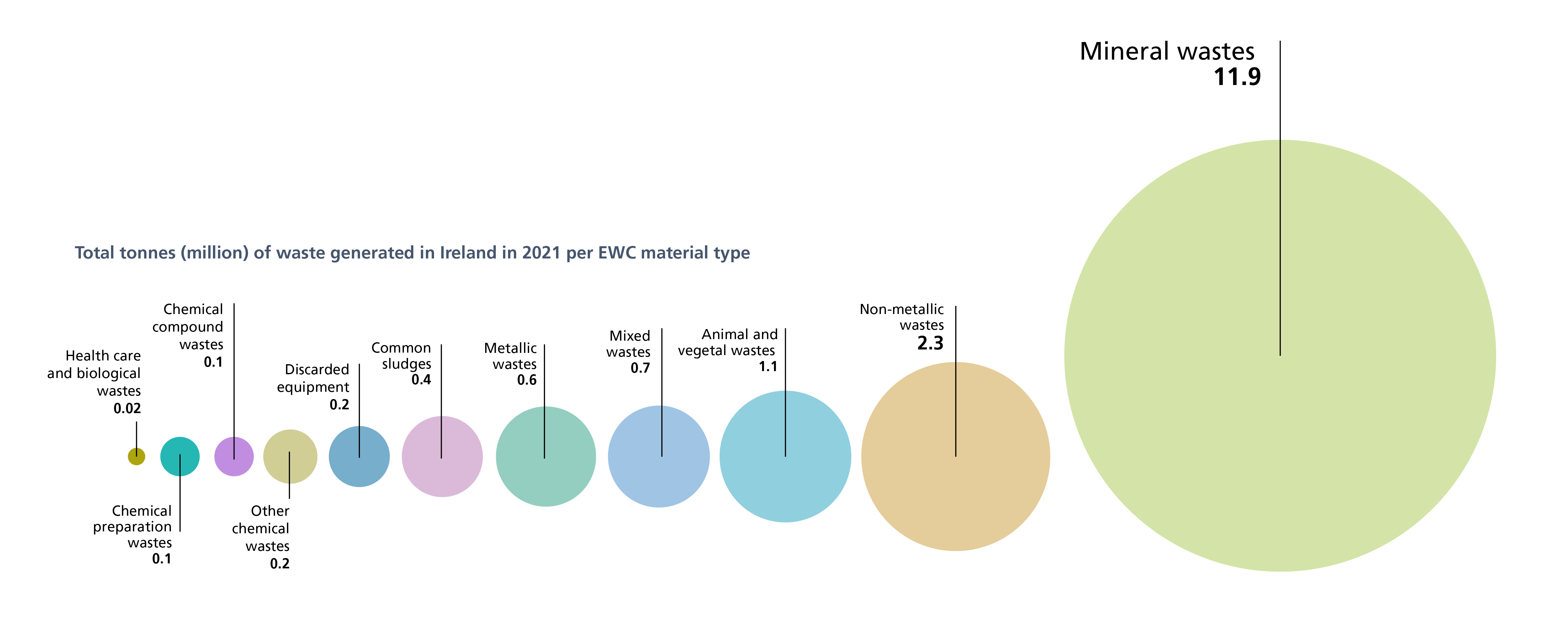EPA Circular Economy and Waste Statistics data release June 2023. Data reference year 2021.
Waste generation refers to the total tonnage of waste that is disposed of and enters the waste management system in Ireland each year. In 2021, 17.6 million tonnes of waste was generated in Ireland (figure 1).

Figure 1: In 2021 Ireland generated 17.6 million tonnes of waste
In 2021, the EPA developed a new approach to calculating total waste generation by individual material type. This gives an annual total figure for waste generation along with a disaggregated view of what materials are present in the different reporting streams. In a circular economy, the aim is to minimise the consumption of new and virgin materials and increase reuse and the use of secondary or recycled materials. Providing detailed information on the types and quantities of materials that make up our waste stream will help inform the development of recycling capacity and circular solutions to reducing overall waste generation.
The calculation of total waste generation measures waste as it is collected and takes account of overlaps across reporting streams to avoid double counting. This waste is then either treated in Ireland or exported for treatment abroad. Waste generation is reported according to the waste categories in the EU’s waste statistics Regulation 2150/2002. These categories provide detail on the material types that make up our waste.
The waste data is categorised using the European Waste Code (EWC) system (table 1) and allows us to present data on quantities and trends in individual material types and is in addition to the data we provide on waste sources through our statutory reporting e.g. municipal, hazardous, C&D waste, etc.
Our new data on waste generation shows that Mineral Wastes are the largest waste material type found in our waste system and account for just under 12 million tonnes or 66% of all waste generated. It includes:
Non-metallic wastes accounts for 2.3 million tonnes or 13% of all waste generated and includes many common materials such as:
Mixed wastes which include sorting residues, street sweepings and other undifferentiated wastes, accounts for 700,000 tonnes.
Metallic wastes which includes aluminium, copper, lead and other metal wastes account for 600,000 tonnes of waste generated.
| EWC Material Category | Tonnes |
|---|---|
| 01 Chemical compound wastes | 97,988 |
| 02 Chemical preparation wastes | 76,994 |
| 03 Other chemical wastes | 156,156 |
| 05 Health care and biological wastes | 22,836 |
| 06 Metallic wastes | 550,842 |
| 07 Non-metallic wastes | 2,296,963 |
| 08 Discarded equipment | 194,853 |
| 09 Animal and vegetal wastes | 1,111,868 |
| 10 Mixed wastes | 733,824 |
| 11 common sludges | 415,298 |
| 12 Mineral wastes | 11,939,624 |
| 13 Solidified, stabilised or vitrified waste | - |
| Grand Total | 17,597,245 |
Table 1. Waste generation per EWC material category in 2021
Ireland's circular economy action plan commits us to improving from third last in Europe to mid table by 2030 in terms of our used of secondary materials. This data provides, for the first time, information on the types and quantities of materials in the waste stream that are available to help us build our circular economy.